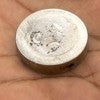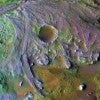
Earth isn’t ‘super’ because the sun had rings before planets
Before the solar system had planets, the sun had rings — bands of dust and gas similar to Saturn’s rings — that likely played a role in Earth’s formation, according to a new study.

Earth isn’t ‘super’ because the sun had rings before planets
Before the solar system had planets, the sun had rings — bands of dust and gas similar to Saturn’s rings — that likely played a role in Earth’s formation, according to a new study.

Air bubbles in Antarctic ice point to cause of oxygen decline
An unknown culprit has been removing oxygen from our atmosphere for at least 800,000 years, and an analysis of air bubbles preserved in Antarctic ice for up to 1.5 million years has revealed the likely suspect.

Sylvia Dee wins fellowship to launch Gulf of Mexico study
Sylvia Dee, an assistant professor of Earth, environmental and planetary sciences, wins an early-career fellowship to pursue Gulf of Mexico research.

Sex and the symbiont: Can algae hookups help corals survive?
Scientists have discovered that symbiotic single-celled algae that live inside of and feed corals can reproduce not only by mitosis, but also sexually. Encouraging sex in these algae can accelerate their evolution to produce strains better able to help reefs cope with climate change.

Nature’s archive reveals Atlantic tempests through time
Rice scientists uncover how natural archives can record Atlantic hurricane frequency over the past 1,000 years. SUMMARY: Rice University scientists uncover how natural archives can record Atlantic hurricane frequency over the past 1,000 years. More data is needed to help model how climate change will affect storms in the future.

Biochar helps hold water, saves money
Biochar’s benefits for long-term storage of carbon and nitrogen on American farms are clear, but new research from Rice University shows it can help farmers save money on irrigation as well.

Seismic study will help keep carbon underground
A Department of Energy grant to Rice geoscientists enables development of fiber-optic sensors to find and evaluate small faults at underground carbon dioxide storage reservoirs.

How planets form controls elements essential for life
How a planet comes together has implications for whether it retains the nitrogen, carbon and water that eventually give rise to life.

Unconventional Students at Rice 2021: Madison Morris has her eye on Mars
Madison Morris ’21 knew two things about herself early on in life: She had an interest in space exploration and she loved Rice University.

Seven research teams win Carbon Hub funding
Carbon Hub, Rice University's zero-emissions research initiative, has awarded seed grants for seven projects that will rapidly advance its vision for transforming the oil and gas sector into a leading provider of both clean hydrogen energy and solid carbon products that can be used in place of materials with large carbon footprints.

Rice team forges path toward geothermal future
Rice scientists have joined a federal project to accelerate breakthroughs in geothermal systems for unlimited, inexpensive energy.

Be there with Martian geologist Kirsten Siebach as the Perseverance rover lands on Mars.

Mark Torres wins Geochemical Society’s Clarke Award
Mark Torres with water samples collected from Iceland's Efri Haukadalsá River in 2016. (Photo by Woodward Fisher)

Rice scientist joins next Mars adventure
A Rice University geologist is one of 13 scientists recently selected to operate the Mars rover Perseverance and analyze samples for an eventual return to Earth.